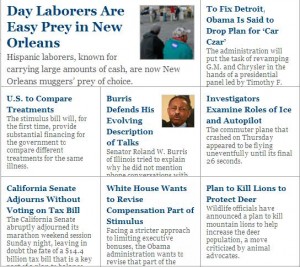Over the last few weeks, the mood in the news industry has shifted from a kind of morbid resignation to one of fiery indignation over the forces that are tearing apart a once-mighty business. The promising development is that media supporters have stopped trying to resurrect a dying print industry and are now focused on saving the essence of quality journalism. They’re getting creative in their approaches. Below are a few recent opinions.
Lean, Mean Media Machine
Writing in the Dallas Morning News, John Chachas says the time has come for the US government to jettison old cross-ownership rules and grant media companies broad license to prosecute people who steal their content.
Chacas, who co-heads the media practice at Lazard, proposes granting news organization “a finite (36-month) anti-trust law exemption to permit deployment of an industry-wide system to track and charge for re-use of their content.” Today’s bloggers thumb their noses at the organizations whose content they steal, and newspapers’ unwillingness to defend their value is their undoing, he says.
Chacas also calls on the government to repeal laws that prohibit media cross-ownership in regional markets. Information no longer knows geographic boundaries, he says, and laws that make it easier for the Los Angeles Daily News to merge with The New York Times than with the Orange County Register are a set of handcuffs on media businesses. Conversely, it’s no longer relevant for the government to try to preserve multiple voices in a market when readers and advertisers no longer believe they’re needed. His four-point proscription is an intelligent call for legal and legislative change.
Reinvent the Model; Save What’s Best
The New York Times rounds up opinions from thought leaders around the industry. The consensus: stop trying to revive the traditional model and focus on finding places to add value.
MinnPost.com CEO Joel Kramer says news organizations will need to derive more revenue from readers in the future, even if that means shrinking circulation: “A newspaper that sold 400,000 copies at 50 cents daily and $1.25 on Sunday might sell only 100,000 at four times the price. But there would be a business incentive to keep quality high, because each extra copy sold should increase profit, not subtract from it.”
Steven Brill mostly agrees. He says the key is to find the crevices where local information needs aren’t being served: “Local newspapers are the best brands, and people will pay a small amount online to get information – whether it be a zoning board meeting or a Little League game – that they can’t get anywhere else.”
Geneva Overholser of the Annenberg School of Journalism is in the same camp. She sees value in a hybrid of community journalists and professional publishers. “These changes will be difficult for newspapers which have considered themselves the primary newsgathers, but they may lead to the next chapter of American journalism,” she writes.
Craig Newmark, whose Craigslist.org is often seen as the Great Satan by the newspaper industry, says media companies need to involve their readers in the process of determining what they do. Quoting David Weinberger, Newmark says, “a paper should be perceived as ‘ours’ (the public) not ‘theirs’ (the owners).” Perhaps the Great Satan is really the newspaper owners.
Author Andrew Keen picks up the thread, suggesting that the future is in a layered model in which community members contribute information that’s then organized by staffs of professional editors. “Rather than slithering into the democratic swamp of crowd-generated content, smart local publishers should focus on their core expertise – the organization and curation of information by professionals,” he writes.
Edward Fouhy of the Pew Center for Civic Journalism tells the story of three small operations that are proud of providing balanced, accurate coverage of local news. “Citizens are inventing a new form of locally based and financed journalism while preserving the values of accuracy, objectivity and independence,” he writes, hopefully.
There are more than 180 comments as of this morning. Thankfully, they are mostly free of the partisan politican ranting that seems to plague this discussion.
BTW, Jack D. Lai thinks micropayments are stupid and he’s got a long list of links to people who agree. It’s an impressive archive and we really hope to get around to reading it all.
Micropayments with a Twist
Steve Outing opens his Editor & Publisher column by dissing micropayments (“that model will only hasten newspapers’ death spiral”) and then goes on to make a passionate case for…micropayments! Okay, we’re oversimplifying. What Outing doesn’t like is the idea that each publisher would have its own system for charging people a few cents to consume its content, sort of like running a PayPal button in the sidebar. He’s right: That’s a dumb idea. The solution may be in a service like Kachingle, a system that distributes payments to website owners based upon their readership.
Kachingle users only have to set up and fund one account. Whenever they visit a site that’s part of the network, Kachingle allocates a portion of their account to that provider. If Newspaper Death Watch gets 20% of your monthly visits, then the owners get 20% of the payment you set aside. Thanks! Readers decide how much they want to pay and Kachingle takes care of the accounting. In theory, the value of the network grows as membership expands. The New York Times may be helping Newspaper Death Watch by joining the network, but the equation also works in reverse. Somehow, we think we’d get the better of that deal.
Steve Outing is nothing if not thought-provoking. Although this column is a tad more enthusiastic than his usual fare, he’s found an interesting model to promote. Hopefully, the column will still be available at SteveOuting.com after E&P inevitably pulls it off its website. You can also comment at SteveOuting.com, but not at E&P.
Miscellany
Last month we told you about The Printed Blog (“Extra! Extra! Blog All About It!”) a startup that’s proposing to reinvigorate print publishing by harvesting content from local bloggers. Simon Owens called up founder Joshua Karp and found an Internet entrepreneur who’s serious about print.
“The print newspaper doesn’t need to go away simply because it’s on paper,” Karp told him. The problem is that publishers haven’t revisited the way they produce their printed products to include the work of the community. The Printed Blog is on thin financial footing unless more funding can be found, Karp said. He’s funding the first issues himself and needs to find venture capital “over the next few weeks.”
They dribble out the news about cuts at the Honolulu Star-Bulletin in this story. The paper will lay off 17 people but wait, there will probably be more. The neighbor island bureaus will be shut down. Oh, and there’ll be a redesign from a broadsheet to a tabloid. Praent Oahu Publications is also discontinuing its Friday edition of the MidWeek tabloid. You have to stick with this story to the end in order to learn everything.
The Charleston Post and Courier has laid off 25 employees after a buyout failed to achieve cost reduction goals. When the company announced its buyout offer in July, the newspaper reported that it had 513 full-time and part-time employees. It will employ 460 people after the latest cuts.






 Yes we can. We just found it on Twitter. And if you came here looking for breaking news about the latest layoffs and cutbacks, you’re wasting your time. This is a daily blog, which is so last year. Instead, subscribe to
Yes we can. We just found it on Twitter. And if you came here looking for breaking news about the latest layoffs and cutbacks, you’re wasting your time. This is a daily blog, which is so last year. Instead, subscribe to 


 Is Mortimer Zuckerman losing it? Or perhaps
Is Mortimer Zuckerman losing it? Or perhaps 
 A decade ago, Napster briefly tried to make music free. When the Recording Industry Association of America applied legal pressure to shut down Napster, the wisdom was that music-sharing would simply be driven underground in a maze of peer-to-peer networks like BitTorrent and
A decade ago, Napster briefly tried to make music free. When the Recording Industry Association of America applied legal pressure to shut down Napster, the wisdom was that music-sharing would simply be driven underground in a maze of peer-to-peer networks like BitTorrent and 

